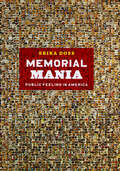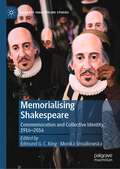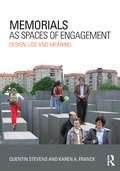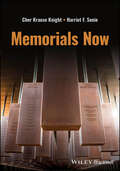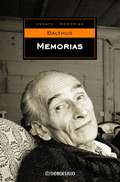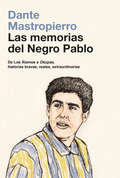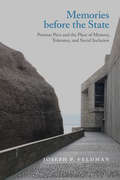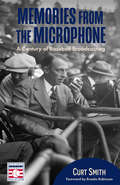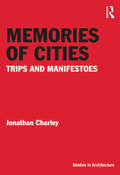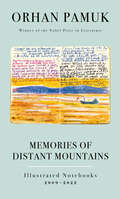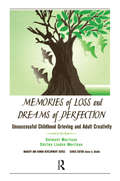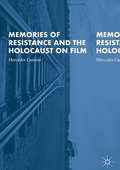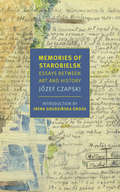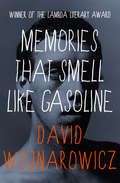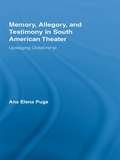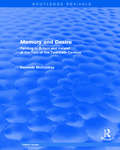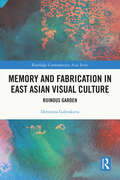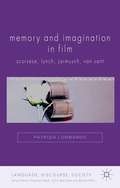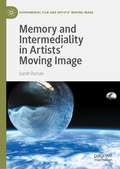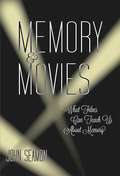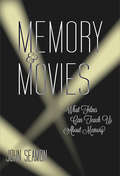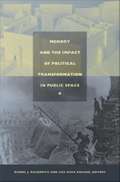- Table View
- List View
Memorial Mania: Public Feeling in America
by Erika DossIn the past few decades, thousands of new memorials to executed witches, victims of terrorism, and dead astronauts, along with those that pay tribute to civil rights, organ donors, and the end of Communism have dotted the American landscape. Equally ubiquitous, though until now less the subject of serious inquiry, are temporary memorials: spontaneous offerings of flowers and candles that materialize at sites of tragic and traumatic death. In Memorial Mania, Erika Doss argues that these memorials underscore our obsession with issues of memory and history, and the urgent desire to express—and claim—those issues in visibly public contexts.Doss shows how this desire to memorialize the past disposes itself to individual anniversaries and personal grievances, to stories of tragedy and trauma, and to the social and political agendas of diverse numbers of Americans. By offering a framework for understanding these sites, Doss engages the larger issues behind our culture of commemoration. Driven by heated struggles over identity and the politics of representation, Memorial Mania is a testament to the fevered pitch of public feelings in America today.
Memorialising Shakespeare: Commemoration and Collective Identity, 1916–2016 (Palgrave Shakespeare Studies)
by Edmund G. C. King Monika SmialkowskaThis book is the first comprehensive account of global Shakespeare commemoration in the period between 1916 and 2016. Combining historical analysis with insights into current practice, Memorialising Shakespeare covers Shakespeare commemoration in China, Ukraine, Egypt, and France, as well as Great Britain and the United States. Chapter authors discuss a broad range of commemorative activities—from pageants, dance, dramatic performances, and sculpture, to conferences, exhibitions, and more private acts of engagement, such as reading and diary writing. Themes covered include Shakespeare’s role in the formation of cultural memory and national and global identities, as well as Shakespeare’s relationship to decolonisation and race. A significant feature of the book is the inclusion of chapters from organisers of recent Shakespeare commemoration events, reflecting on their own practice. Together, the chapters in Memorialising Shakespeare show what has been at stake when communities, identity groups, and institutions have come together to commemorate Shakespeare.
Memorials as Spaces of Engagement: Design, Use and Meaning
by Karen A. Franck Quentin StevensMemorials are more diverse in design and subject matter than ever before. No longer limited to statues of heroes placed high on pedestals, contemporary memorials engage visitors in new, often surprising ways, contributing to the liveliness of public space. In Memorials as Spaces of Engagement Quentin Stevens and Karen A. Franck explore how changes in memorial design and use have helped forge closer, richer relationships between commemorative sites and their visitors. The authors combine first hand analysis of key examples with material drawn from existing scholarship. Examples from the US, Canada, Australia and Europe include official, formally designed memorials and informal ones, those created by the public without official sanction. Memorials as Spaces of Engagement discusses important issues for the design, management and planning of memorials and public space in general. The book is organized around three topics: how the physical design of memorial objects and spaces has evolved since the 19th century; how people experience and understand memorials through the activities of commemorating, occupying and interpreting; and the issues memorials raise for management and planning. Memorials as Spaces of Engagement will be of interest to architects, landscape architects and artists; historians of art, architecture and culture; urban sociologists and geographers; planners, policymakers and memorial sponsors; and all those concerned with the design and use of public space.
Memorials Now
by Cher Krause Knight Harriet F. SenieA comprehensive guide to addressing the present-day challenges of commemorating the past As debates over historical monuments and their meanings unfold, Memorials Now offers a critical exploration of how communities can navigate the complex terrain of commemorative practices. From controversial statues to emerging forms of public memory, the topics covered in this timely volume provide insights into historical challenges while also encouraging a more inclusive and just memorial landscape for the future. Authors Cher Krause Knight and Harriet F. Senie explore evolving narratives of heroes and victims, ethical challenges of memorial design, strategies for promoting inclusivity, and possibilities for alternative forms of commemoration. Memorials Now analyzes case studies from around the world in which communities are rethinking their memorials and creating innovative memorialization projects that reflect shifting cultural values. Memorials Now is ideal for students and educators in art history, architecture, urban planning, and cultural studies, as well as professionals in fields such as public art, city planning, museum curation, and civic engagement.
Memorias
by Balthus«La vida ha sido para mí una larga tarea de la que no me arrepiento en absoluto», comenta Balthus en una de las páginas de este magnífico libro de memorias, y esas son quizá las palabras que mejor resumen la trayectoria vital de un hombre consagrado a la pintura con el mismo afán y la misma humildad con que otros se entregan a la religión. Convencido desde muy joven de su condición de artesano y poco dispuesto a dejarse llevar por los reclamos de la vanguardia, Balthus se dedicó a estudiar a los grandes maestros, intentando penetrar los matices de esa luz tan peculiar que desprenden las telas de Masaccio, de Piero della Francesca y Giotto. Ahí, en la atenta contemplación de los primitivos italianos, el joven pintor pudo tejer un hilo que une Oriente con Occidente, y a Fra Angélico con Poussin y Cézanne, hasta llegar a nuestros días. Amigo personal de Modigliani y Picasso, instalado desde hacía muchos años en la mansión de Rossinière, Balthus dictó estas memorias cuando su vida ya se acababa, hablando por fin del auténtico significado de algunos de sus cuadros y de la búsqueda incansable, desesperada a veces, de una perfección que iba más allá de la técnica para instalarse en la ética. Hombre modesto y esquivo, Balthus, que solo habló cuando dejó de utilizar el pincel, nos ha dejado unas páginas hermosas donde se guarda la esencia de un arte que es oficio y es vocación.
Las memorias del negro Pablo
by Dante MastropierroDe Los Álamos a Okupas, historias bravas, reales, extraordinarias. A través de un anecdotario compuesto por una contundente secuencia de historias poderosas, divertidas, a veces sórdidas pero siempre auténticas, Dante Mastropierro, el actor más conocido como el Negro Pablo en la serie de culto Okupas, cuenta su vida por primera vez. De las andanzas con gomeras a las venganzas con alambres de púa, entre pistoleros de verdad y luego de ficción, de La Boca a Quilmes, de Quilmes al Docke. De los códigos de la calle a los códigos de Okupas. Una infancia de perros fieros, una madre amorosa, una soledad insoportable. Noches de baile, romances prohibidos y viejos tumberos. Los turros y los boquita de nylon. La vida antes y después de la televisión. El comedor y Maradona. Los que ya no están. "Me acuerdo de cosas que me pasaron cuando tenía dos o tres años", dice Dante Mastropierro mientras emprende un emocionante, furioso, divertido y siempre honesto recorrido por el pasado. "Me gustaría no acordarme de todo pero las cosas están ahí, en mi cabeza. Después de hacer del Negro Pablo en Okupas, muchos me decían: che, con las historias que viviste, tendrías que hacer un libro. Pero, más allá de los recuerdos, lo importante para mí es no olvidarme de dónde salí, de dónde vengo, de dónde soy". Del prólogo de Bruno Stagnaro: Había algo en él, una especie de áspera verdad callejera que saltaba a la vista y que podía funcionar muy bien en el proyecto que estábamos gestando [Okupas]. Incluso mientras filmábamos, Dante era un misterio para nosotros. Sentíamos que lo conocíamos y que podíamos confiar en él, pero al mismo tiempo había una barrera invisible... Definitivamente, percibíamos algo salvaje (que era justo lo que buscábamos), aunque todavía no conocíamos su otro lado, tan persistente como el bravío: su ternura. Diego Alonso, "El Pollo" de Okupas: Dante es el amigo más fuerte que me quedó de Okupas: un amigo para toda la vida y para las próximas vidas también. Es muy loco: cada vez que llega a un lugar, genera un frío en el ambiente, porque nadie sabe lo que puede suceder. Y eso es gracioso porque Dante es un corazón con patas, un tipo maravilloso. Ha tenido una vida complicada pero cuando cuenta cosas que a otro lo hubiesen devastado, él lo hace con alegría, siempre.
Memories before the State: Postwar Peru and the Place of Memory, Tolerance, and Social Inclusion (Genocide, Political Violence, Human Rights)
by Joseph P. FeldmanMemories before the State examines the discussions and debates surrounding the creation of the Place of Memory, Tolerance, and Social Inclusion (LUM), a national museum in Peru that memorializes the country’s internal armed conflict of the 1980s and 1990s. Emerging from a German donation that the Peruvian government initially rejected, the Lima-based museum project experienced delays, leadership changes, and limited institutional support as planners and staff devised strategies that aligned the LUM with a new class of globalized memorial museums and responded to political realities of the country’s postwar landscape. The book analyzes forms of authority that emerge as an official institution seeks to incorporate and manage diverse perspectives on recent violence.
Memories from the Microphone: A Century of Baseball Broadcasting
by Curt SmithVoices of the GameCurt Smith is “…the voice of authority on baseball broadcasting.” —USA Today#1 New Release in Photography, Baseball Statistics, Photo Essays, and Photojournalism In this second in a series of Baseball Hall of Fame books, celebrate the larger-than-life role played by radio and TV baseball announcers in enhancing the pleasure of our national pastime.Commemorate the 100th anniversary of baseball broadcasting. The first baseball game ever broadcast on radio was on August 5, 1921 by Harold Wampler Arlin, a part-time baseball announcer on Pittsburgh’s KDKA, America’s first commercially licensed radio station. The Pirates defeated the Phillies 8-5.An insider’s view of baseball. Now you can own Memories from the Microphone and experience baseball from author Curt Smith. He has spent much of his life covering baseball radio and TV, and previously authored baseball books including the classic Voices of The Game.Relive baseball’s storied past through the eyes of famed baseball announcers. Organized chronologically, Memories from the Microphone charts the history of baseball broadcasting. Enjoy celebrated stories and personalities that have shaped the game—from Mel Allen to Harry Caray, Vin Scully to Joe Morgan, Ernie Harwell to Red Barber.Also discover:Images from the Baseball Hall of Fame’s matchless archiveAnecdotes and quotes from Curt Smith’s original researchInterviews with broadcast greatsLittle-known stories, such as Ronald Reagan calling games for WHO Des Moines in the 1930sAccounts of diversity in baseball broadcasting, including the TV coverage of Joe Morgan and earlier Hispanic pioneers Buck Canel and Rafael (Felo) RamirezA special section devoted to the Ford C. Frick Award and inductees since its inception in 1978Also take a nostalgic trip down baseball's memory lane with other Baseball Hall of Fame books: Picturing America’s Pastime, So You Think You Know Baseball, and Baseball Memories and Dreams.
Memories of Cities: Trips and Manifestoes (Ashgate Studies In Architecture Ser.)
by Jonathan CharleyMemories of Cities is a collection of essays that explore different ways of writing about the political and economic history of the built environment. Drawing upon fiction and non-fiction, and illustrated by original photographs, the essays employ a variety of narrative forms including memoirs, letters, and diary entries. They take the reader on a journey to cities such as Glasgow, Paris, Moscow, St. Petersburg, and Marseille, laying bare the contradictions of capitalist architectural and urban development, whilst simultaneously revealing alternative visions of how buildings and cities might be produced and organised.
Memories of Distant Mountains: Illustrated Notebooks, 2009-2022
by Orhan PamukWINNER OF THE NOBEL PRIZE IN LITERATURE • Beautiful, full-colour selections from Orhan Pamuk&’s selected art notebooks.&“One of the world's finest living writers.&” The Independent&“In this world of forgeries, where some might be in danger of losing their faith in literature, Pamuk is the real thing.&” The ObserverFor many years, Orhan Pamuk kept a record of his daily thoughts and observations, entering them in small notebooks and illustrating them with his own paintings. This book combines those notebooks into one volume. He writes about his travels around the world, his family, his writing process, and his complex relationship with his home country of Turkey. He charts the seeds of his novels and the things that inspired his characters and the plots of his stories. Intertwined in his writings are the vibrant paintings of the landscapes that surround and inspire him.A beautiful object in its own right, in Memories of Distant Mountains readers can explore Pamuk's intoxicating inner world and can have a fascinating, intimate encounter with the art, culture, and charged political currents that have shaped one of literature&’s most important voices.
Memories of Distant Mountains: Illustrated Notebooks, 2009-2022
by Orhan PamukThe journals of the Nobel Prize–winning author, beautifully illustrated with his own paintingsFor many years, Orhan Pamuk kept a record of his daily thoughts and observations, entering them in small notebooks and illustrating them with his own paintings. This book combines those notebooks into one volume. He writes about his travels around the world, his family, his writing process, and his complex relationship with his home country of Turkey. He charts the seeds of his novels and the things that inspired his characters and the plots of his stories. Intertwined in his writings are the vibrant paintings of the landscapes that surround and inspire him.A beautiful object in its own right, in Memories of Distant Mountains readers can explore Pamuk's intoxicating inner world and can have a fascinating, intimate encounter with the art, culture, and charged political currents that have shaped one of literature&’s most important voices.
Memories of Loss and Dreams of Perfection: Unsuccessful Childhood Grieving and Adult Creativity
by Delmont C Morrison Shirley Linden MorrisonWith "Memories of Loss and Dreams of Perfection", Delmont and Shirley Morrison have made an impressive contribution to psychology and to the appreciation of literature by demonstrating the ways in which a children's imaginative play can help them cope with the tragic early loss of beloved family members and by tracing how such early play processes form the basis for adult creativity. Their book is unique in that it: presents new ideas and expands our understanding of the complex interrelationships among loss, child development and creativity, and presents clinical cases of play therapy and case studies of creative adults to illustrate theory and concepts. The Morrisons incorporate scientific research, clinical case studies, and biographies in a manner that provides a deeper understanding of the fiction of Emily Bronte, J.M. Barrie, Jack Kerouac and Isak Dinesen. Readers will be deeply touched and moved to self-exploration by the humanity and sensitivity of this fine book.
Memories of Resistance and the Holocaust on Film
by Mercedes CaminoThis book investigates cinematic representations of the murder of European Jews and civilian opposition to Nazi occupation from the war up until the twenty-first century. The study exposes a chronology of the conflict’s memorialization whose geo-political alignments are demarcated by vectors of time and space—or ‘chronotopes’, using Mikhail Bakhtin’s term. Camino shows such chronotopes to be first defined by the main allies; the USA, USSR and UK; and then subsequently expanding from the geographical and political centres of the occupation; France, the USSR and Poland. Films from Western and Eastern Europe and the USA are treated as primary and secondary sources of the conflict. These sources contribute to a sentient or emotional history that privileges affect and construct what Michel Foucault labels biopolitics. These cinematic narratives, which are often based on memoirs of resistance fighters like Joseph Kessel or Holocaust survivors such as Primo Levi and Wanda Jakubowska, evoke the past in what Marianne Hirsch has described as ‘post-memory’.
Memories Of The Revolution: The First Ten Years Of The Wow Café Theater
by Holly Hughes Carmelita Tropicana Jill DolanThe women's experimental theater space called the WOW Café (Women's One World) has been a vital part of New York's downtown theater scene since 1980. Since that time, WOW has provided a place for feminist and particularly lesbian theater artists to create, perform, and witness a cultural revolution. Its renowned alumnae include playwright and actor Lisa Kron, performance artists Holly Hughes and Carmelita Tropicana, the theater troupe the Five Lesbian Brothers, and actors/playwrights Peggy Shaw, Lois Weaver, and Deb Margolin, among others. Memories of the Revolution collects scripts, interviews, and commentary to trace the riotous first decade of WOW. While the histories of other experimental theater collectives have been well documented, WOW's history has only begun to be told. The anthology also includes photographs of and reminiscences by Café veterans, capturing the history and artistic flowering of the first ten years of this countercultural haven.
Memories of Starobielsk: Essays Between Art and History
by Jozef CzapskiVivid accounts of life in a Soviet prison camp by the author of Inhuman Land.Interned with thousands of Polish officers in the Soviet prisoner-of-war camp at Starobielsk in September 1939, Józef Czapski was one of a very small number to survive the massacre in the forest of Katyń in April 1940. Memories of Starobielsk portrays these doomed men, some with the detail of a finished portrait, others in vivid sketches that mingle intimacy with respect, as Czapski describes their struggle to remain human under hopeless circumstances. Essays on art, history, and literature complement the memoir, showing Czapski&’s lifelong engagement with Russian culture. The short pieces on painting that he wrote while on a train traveling from Moscow to the Second Polish Army&’s strategic base in Central Asia stand among his most lyrical and insightful reflections on art.
Memories That Smell Like Gasoline
by David WojnarowiczAutobiographical stories and drawings by the artist and AIDS activist featured in the new documentary by Chris McKim. For most of his life, David Wojnarowicz considered himself the ultimate outsider and a true invisible man. &“I&’m a blank spot in a hectic civilization,&” he writes in this fierce and unforgettable collection of four blistering autobiographical pieces, illustrated with his own arresting ink drawings. Wojnarowicz, who died of AIDS in New York City at the age of thirty-seven, left behind a body of work that was staggering in its variety and originality. Painter, writer, photographer, performance artist, and filmmaker, he made an indelible mark on virtually every stage of the national arts scene. Yet nowhere does his anger, love, or compassion show itself as strongly as in his writing, which earned a Lambda Literary Award and prompted critics to call him the Jack Kerouac of his generation. The horrors of Wojnarowicz&’s past inform his literature—his years spent as a child prostitute and living homeless on the New York streets, his outspoken, very public battle against the disease that would eventually take his life, and the entrenched government bureaucracy that sat by and did nothing. The world as seen through Wojnarowicz&’s eyes in these four masterful short works is stark, cruel, and cold—and yet gloriously alive, ennobled by surprising acts of heartrending humanity. Memories That Smell Like Gasoline is a celebration of sorts: of sex, of love, of art, and of having truly lived.
Memory: Shaping Connections in the Arts Therapies
by Richard Hougham Sarah Scoble Marián CaoMemory is compilation of scholarly chapters by authors of global reputation in the arts therapies.This international publication reflects the theme of the 16th International Conference of the European Consortium for Arts Therapies (ECArTE), held in Vilnius, Lithuania. Questions of memory go to the very heart of our making sense of the world. This book brings together wide-ranging chapters, which address the question of memory, designed to stimulate understanding and debate in contemporary arts therapy education, practice and research.Writers from Canada, Estonia, Germany, Iceland, Lebanon, Lithuania, Spain, the UK and the US combine to create a topical publication, incorporating diverse and current thinking in art therapy, dance movement therapy, dramatherapy and music therapy. In this innovative compilation, authors offer different cultural perspectives on the conception of memory which informs epistemology across the field of arts therapy.This book will be of interest and relevance to those in the arts therapy community and to a broader readership, including students and professionals in the disciplines of psychology, sociology, psychotherapy, the arts, medicine, integrated health and education.
Memory, Allegory, and Testimony in South American Theater: Upstaging Dictatorship (Routledge Advances in Theatre & Performance Studies #Vol. 8)
by Ana Elena PugaMemory, Allegory, and Testimony in South American Theater traces the shaping of a resistant identity in memory, its direct expression in testimony, and its indirect elaboration in two different kinds of allegory. Each chapter focuses on one contemporary playwright (or one collaborative team, in the case of Brazil) from each of four Southern Cone countries and compares the playwrights’ aesthetic strategies for subverting ideologies of dictatorship: Carlos Manuel Varela (memory in Uruguay), Juan Radrigán (testimony in Chile), Augusto Boal and his co-author Gianfrancesco Guarnieri (historical allegory in Brazil), Griselda Gambaro (abstract allegory in Argentina).
Memory and Desire: Painting in Britain and Ireland at the Turn of the Twentieth Century (British Art And Visual Culture Since 1750: New Readings Ser.)
by Kenneth McConkeyThis title was first published in 2002. 'Memory and Desire' is a lavishly illustrated account of the art world in Britain at the turn of the twentieth century. It calls upon rich resources of contemporary diaries, letters and art criticism, as well as the analysis of works of art to answer questions about how and why new artistic tendencies emerged and tastes changed. Eschewing the familiar narrative of an inevitable progress towards modernism, Kenneth McConkey considers a broad range of art and critical thinking in the period. Discussing the market for old master paintings, which rivalled those for modern art, and the question of how and why certain genres of art were particularly successful at the time, McConkey explores the detail and significance of contemporary taste. He draws upon the work of commercially successful painters such as John Singer Sargent, William Orpen, George Clausen, Alfred East, John Lavery and Philip Wilson Steer, and their critic-supporters to throw light upon current arguments about training, aesthetics, visual memory and the creation of new art. 'Memory and Desire' is a major contribution to our knowledge of this important period in British art.
Memory and Fabrication in East Asian Visual Culture: Ruinous Garden (Routledge Contemporary Asia Series)
by Dennitza GabrakovaThis book examines four contemporary sites of visual culture in East Asia through the poetic prism of the “ruinous garden.” Framing destroyed, discarded, and displaced material objects within a rhetoric of development and relating this to the experience of ethnic/national culture, the book presents succinct analyses of visual works, as well as cultural criticisms, centered on space in metropolitan Japan and Hong Kong, China. These analyses are placed in dialog with approaches from postcolonial texts, addressing development and fractures in representation. Additionally, the book suggests graphic design as a form of retrospective cultural thinking, encompassing visual and invisible modernity, as well as an attachment to disappearing space. Offering a unique and thorough analysis of Japanese visual culture, combining discussion on photography, installation art, and graphic design, as well as integrating material from Hong Kong visual culture in discussions of identity, this book will appeal to students and scholars of visual culture in East Asia, environmental art, and environmental humanities.
Memory and Imagination in Film: Scorsese, Lynch, Jarmusch, Van Sant (Language, Discourse, Society)
by Scorsese Lynch Jarmusch Van SantInspired by Baudelaire's art criticism and contemporary theories of emotions, and developing a new aesthetic approach based on the idea that memory and imagination are strongly connected, Lombardo analyzes films by Scorsese, Lynch, Jarmusch and Van Sant as imaginative uses of the history of cinema as well as of other media.
Memory and Intermediality in Artists’ Moving Image (Experimental Film and Artists’ Moving Image)
by Sarah DurcanThis book addresses the preoccupation with memory in contemporary artists’ moving image installations. It situates artists’ moving image in relation to the transformations of digitalization as hybrid intermedial combinations of analogue film, video and digital video emerge from mid 1990s onwards. While film has always been closely associated with the process of memory, this book investigates new models of memory in artists’ remediation of film with video and other intermedial aesthetics. Beginning with a chapter on the theorization of memory and the moving image and the diverse genealogies of artists’ film and video, the following chapters identify five different mnemonic modes in artists’ moving image: critical nostalgia, database narrative, the ‘echo-chamber’, documentary fiction and mediatized memories. Stan Douglas, Steve McQueen, Runa Islam, Mark Leckey and Elizabeth Price are of a generation that has lived through the transition from analogue to digital. Their emphasis on the nuances of intermediality indicates the extent to which we remember through media.
Memory and Movies
by John SeamonIn the movie Slumdog Millionaire, the childhood memories of a young game show contestant trigger his correct answers. In Memento, the amnesiac hero uses tattoos as memory aids. In Away from Her, an older woman suffering from dementia no longer remembers who her husband is. These are compelling films that tell affecting stories about the human condition. But what can these movies teach us about memory? In this book, John Seamon shows how examining the treatment of memory in popular movies can shed new light on how human memory works. After explaining that memory is actually a diverse collection of independent systems, Seamon uses examples from movies to offer an accessible, nontechnical description of what science knows about memory function and dysfunction. In a series of lively encounters with numerous popular films, he draws on Life of Pi and Avatar, for example, to explain working memory, used for short-term retention. He describes the process of long-term memory with examples from such films as Cast Away and Groundhog Day; The Return of Martin Guerre, among other movies, informs his account of how we recognize people; the effect of emotion on autobiographical memory is illustrated by The Kite Runner, Titanic, and other films; movies including Born on the Fourth of July and Rachel Getting Married illustrate the complex pain of traumatic memories. Seamon shows us that movies rarely get amnesia right, often using strategically timed blows to the protagonist's head as a way to turn memory off and then on again (as in Desperately Seeking Susan). Finally, he uses movies including On Golden Pond and Amour to describe the memory loss that often accompanies aging, while highlighting effective ways to maintain memory function.
Memory and Movies: What Films Can Teach Us about Memory (The\mit Press Ser.)
by John SeamonHow popular films from Memento to Slumdog Millionaire can help us understand how memory works.In the movie Slumdog Millionaire, the childhood memories of a young game show contestant trigger his correct answers. In Memento, the amnesiac hero uses tattoos as memory aids. In Away from Her, an older woman suffering from dementia no longer remembers who her husband is. These are compelling films that tell affecting stories about the human condition. But what can these movies teach us about memory? In this book, John Seamon shows how examining the treatment of memory in popular movies can shed new light on how human memory works. After explaining that memory is actually a diverse collection of independent systems, Seamon uses examples from movies to offer an accessible, nontechnical description of what science knows about memory function and dysfunction. In a series of lively encounters with numerous popular films, he draws on Life of Pi and Avatar, for example, to explain working memory, used for short-term retention. He describes the process of long-term memory with examples from such films as Cast Away and Groundhog Day; The Return of Martin Guerre, among other movies, informs his account of how we recognize people; the effect of emotion on autobiographical memory is illustrated by The Kite Runner, Titanic, and other films; movies including Born on the Fourth of July and Rachel Getting Married illustrate the complex pain of traumatic memories. Seamon shows us that movies rarely get amnesia right, often using strategically timed blows to the protagonist's head as a way to turn memory off and then on again (as in Desperately Seeking Susan). Finally, he uses movies including On Golden Pond and Amour to describe the memory loss that often accompanies aging, while highlighting effective ways to maintain memory function.
Memory and the Impact of Political Transformation in Public Space
by Daniel J. Walkowitz Lisa Maya KnauerMemory and the Impact of Political Transformation in Public Space explores the effects of major upheavals--wars, decolonization, and other social and economic changes--on the ways in which public histories are presented around the world. Examining issues related to public memory in twelve countries, the histories collected here cut across political, cultural, and geographic divisions. At the same time, by revealing recurring themes and concerns, they show how basic issues of history and memory transcend specific sites and moments in time. A number of the essays look at contests over public memory following two major political transformations: the wave of liberation from colonial rule in much of Africa, Asia, and Central and South America during the second half of the twentieth century and the reorganization of Eastern Europe and the former Soviet bloc beginning in the late 1980s. This collection expands the scope of what is considered public history by pointing to silences and absences that are as telling as museums and memorials. Contributors remind us that for every monument that is erected, others--including one celebrating Sri Lanka's independence and another honoring the Unknown Russian Soldier of World War II--remain on the drawing board. While some sites seem woefully underserved by a lack of public memorials--as do post-Pinochet Chile and post-civil war El Salvador--others run the risk of diluting meaning through overexposure, as may be happening with Israel's Masada. Essayists examine public history as it is conveyed not only in marble and stone but also through cityscapes and performances such as popular songs and parades. Contributors James Carter John Czaplicka Kanishka Goonewardena Lisa Maya Knauer Anna Krylova Teresa Meade Bill Nasson Mary Nolan Cynthia Paces Andrew Ross Daniel Seltz T. M. Scruggs Irina Carlota Silber Daniel J. Walkowitz Yael Zerubavel
